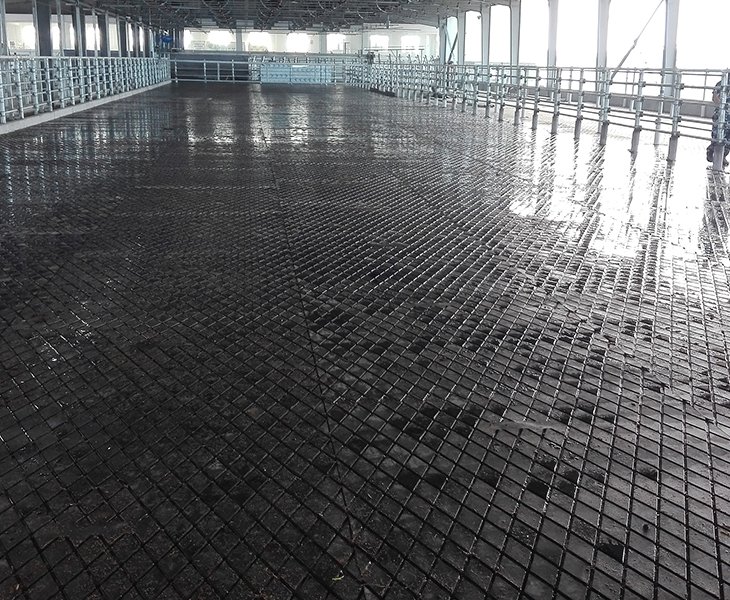AOBO Cow Mat
Rubber cow mats are rubber mats for walking in passages. They are mainly used to improve the livestock breeding environment, provide insulation and heat preservation functions, and have anti-slip effects. This mat is usually made of wear-resistant and anti-slip rubber, with a variety of specifications and thickness options, suitable for different usage scenarios, such as milking parlors, cattle passages, etc.
AOBO’s products cover a variety of styles, including hammer back grooves, large dot wide grooves, arrows, honeycombs, small squares, diamonds, and other designs. With highly competitive prices and efficient supply chain management, AOBO ensures that you can enjoy the best cost-effectiveness while getting high-quality products.
By choosing AOBO, you will get excellent product quality, caring service experience, and a long-term and reliable partner to jointly promote the efficient operation and sustainable development of the farm!
Benefits of AOBO Cow Mat
- Very durable – Cow mats can withstand a lot of pressure and traffic, and withstand heavy agricultural wear and tear.
- Anti-slip – Protect cows from falling, provide a durable and shock-absorbing surface for cows to stand, walk, and lie, and ensure safety.
- Traction – Even in wet conditions, the surface provides maximum grip for cows’ feet and hooves to traffic, reducing the pressure on cows’ joints.
- Cost-effectiveness – Reduce the cost and time of cleaning, save animal treatment costs, and bedding costs, and reduce maintenance costs, achieving long-term savings.
- Comfort – Anti-fatigue properties can reduce pressure on cows’ feet and legs while isolating them from the cold and wet ground below. Extend livestock life and increase milk production.
- Easy to clean and maintain – Improve cowshed and barn hygiene, facilitate the discharge of liquids, prevent bacterial growth, and rubber mats can be easily swept, shoveled, or rinsed with a hose.


Why Choose the AOBO Cow Mat?
AOBO cow mat provides you with a one-stop solution to meet all your cattle mat needs:
- Rich and diverse choices: Whether it is the top hammer-type thin rib bottom, the top stud-type groove bottom, the top diamond flat bottom, or the top honeycomb square bottom, we can provide the style you need.
- Flexible and diverse specifications: We provide cow mats in various thicknesses and sizes, and you can choose rolls or sheets to flexibly adapt to your cattle shed.
- Competitive prices: We are committed to providing you with cost-effective products so that you can get higher value at a lower cost.
- Complete installation guidance: Don’t worry even if it is your first installation, we provide comprehensive and detailed installation instructions to make it easy for you to complete the installation.
AOBO Cow Mat Application Scenarios
Rubber cow mats are widely used in cowshed waiting areas, milking halls, cow channels, feeding paths, feeding areas, feeding channels, cow platforms, weighing platforms, and other walkway places.
Its anti-slip design can effectively prevent livestock from slipping when walking or lying down, and its function of keeping livestock cool and warm also helps improve the comfort of livestock.

Maintenance methods include:
- Daily cleaning: regularly sweep or rinse the surface of the mat to remove feces and dirt.
- Regular inspection: check whether the mat is worn or shifted, and adjust or replace it in time.
- Disinfection: Use neutral detergent or disinfectant to prevent bacterial growth.
- Avoid exposure to the sun: Long-term exposure to the sun may cause rubber aging. It is recommended to set up sunshade facilities above the passage.
Yes, our rubber cow mats are made of environmentally friendly rubber materials and are recyclable, which is in line with the sustainable development concept of the modern breeding industry.
AOBO provides cow mats with different performance indicators. Under normal use and maintenance, the service life of AOBO rubber cow mats can reach 3-10 years. The specific service life depends on the specific performance parameters, frequency of use, environmental conditions, maintenance methods, etc. Generally, there are 3-5 years, 5-8 years, and more than 10 years.



